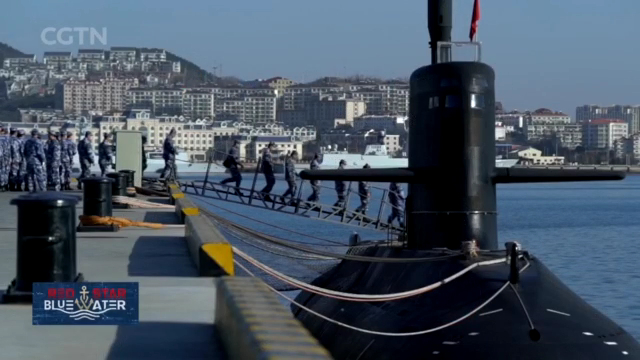
13:30, 20-Apr-2019
China's Underwater Force: PLAN prioritizes modernization of its submarine force
Updated
13:30, 23-Apr-2019
05:01

The submarine force of the People's Liberation Army Navy is crucial in the Navy's overall strength. With the changing naval strategy, the submarine force is on course to more distant waters. Today in our special series "Red Star, Blue Water", CGTN correspondent Han Bin has exclusive access to one of China's conventional submarines and crew. He finds out how the navy is speeding up modernization.
One of the most lethal weapons in or on the sea. Usually beneath the surface, and training away from prying eyes.
"Concealment is the life and death of a submarine. This is the way of submarine sailors, living under water for a long time. Life is relatively dull."
At a military port on China's east coast is a submarine unit. Its missions can take the crew anywhere and anytime. We follow them into the heart of the vessel. Captain Zhao Haijun is inside the conference room. He stresses the crew must be on alert at all times, to drive the point home. The message is that training must be intensified to optimize performance.
ZHAO HAIJUN, CAPTAIN NORTH CHINA SEA FLEET "Serving on a submarine is a risky job. But I think this risk can be controlled. As long as each crew member follows the rules and carefully implements actions based on them, then the risks are nothing."
Seaman Wang Xiaolong takes me to the living area. The 26-year-old has been serving on this ship ever since it was commissioned some 6 years ago. He says the cramped quarters are not the biggest challenge, it's living under water.
SEAMAN WANG XIAOLONG NORTH CHINA SEA FLEET "Don't ask me where I am. Even if you ask, I can't tell you. We are the nameless heroes. I chose this career so I have to do it well. We can't see, and there's no concept of day and night. The 24-hour clock tells us whether it's night or day. Vegetables are generally stored for only a short time. For distant missions, we usually take blanched vegetables and canned goods."
Everyone has their own role in the mission. Wang Xiaolong works from the bridge, where he has a view of the water when the submarine is on the surface. He shows me the navigation meters and their functions. This is a 039B type submarine, representative of some of the Navy's current core strength. The improved weaponry is a source of pride for Wang.
"Its hydrodynamic design helps keep it invisible under water. The level of informationization and automation is quite high. We've been working and living on this submarine for a long time. Our feelings towards it are of particular kind. It is just like a comrade-in-arms. The main content of the onshore rehearsals is emergency operations. When we are fully competent, we can transfer to offshore training."
The 039B is equipped with air-independent propulsion technology, and advanced systems that help it dive deeper, and move faster and more quietly.
"Comprehensive rehearsals and training can produce spontaneous and immediate emergency reactions. Many reactions and actions are counted in seconds."
ZHAO HAIJUN NORTH CHINA SEA FLEET "Hard training onshore, precision training offshore. Only when these practices are mastered onshore can we ensure offshore operations without a single failure in ten thousand tests."
HAN BIN EAST CHINA SEA FLEET "After a late start in the 1960s, China prioritized submarine development in its military modernization. Today, the fleet includes both nuclear-powered and diesel-electric submarines. The PLA's underwater force is expected to continue to grow, as the navy focuses more on blue water missions."
"We need to make the best use of our existing equipment and human resources. Combining the new equipment, new strength with our personnel, we have to do our part for our submarine force in creating a world-class navy."
It's all calm for now, but the Navy knows there's strength in silence. Han Bin, CGTN, from a submarine port in east China.

SITEMAP
Copyright © 2018 CGTN. Beijing ICP prepared NO.16065310-3
Copyright © 2018 CGTN. Beijing ICP prepared NO.16065310-3